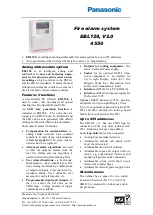
6 / 25
P/N 3102145 (ML) • REV F • ISS 11MAR19
•
Avoid spraying air fresheners, hair spray, paint, or other
aerosols near the alarm.
•
Do not paint the alarm. Paint will seal the vents and
interfere with proper sensor operation.
Move the CO alarm to a remote location, to prevent possible
damage or contamination of the sensor, prior to performing any
of the following:
•
Staining or stripping floors or furniture, painting or wall-
papering.
•
Using aerosols or adhesives.
WARNING:
Reinstall the CO sensor as soon as
possible to assure continuous protection.
The following is a list of substances that at high levels can
damage the CO sensor or cause temporary readings that are
not CO readings:
•
Ethylene, ethanol, alcohol, iso-propanol, benzene,
toluene, ethyl acetate, hydrogen, hydrogen sulfide, and
sulfur dioxide
•
Also most aerosol sprays, alcohol-based products, paint,
thinner, solvent, adhesive, hair spray, after shave,
perfume, auto exhaust (cold start), and some cleaning
agents
Emergency Actions
If a carbon monoxide alarm initiates an alarm signal it is
recommended that the following actions are taken in the order
given:
1) Keep calm and
open all doors and windows
to increase
the rate of ventilation, but see also item a) below.Stop using all
fuel-burning appliances and ensure, if possible, that they are
turned off, e.g. for gas appliances, isolate the emergency
control valve.
2) If the alarm continues to be activated, then
evacuate the
premises
. Leave the doors and windows open, and only re-
enter the building when the alarm has stopped. In multi-
occupancy and multi-storey premises, ensure that all the
occupants are alerted to the risk.
3)
Get medical help
for anyone suffering the effects of carbon
monoxide poisoning, see Table 1, and advise that carbon
monoxide inhalation is suspected.
4) Telephone the appropriate appliance servicing and/or
maintenance agency or, when necessary, the relevant fuel
supplier on their emergency number or the national Gas
Emergency Service Provider, if appropriate, so that the source
of carbon monoxide emissions can be identified and corrected.
Unless the reason for the alarm is obviously spurious (see
item c) below),
do not use the fuel-burning appliances
again, until they have been checked and cleared for use by a
competent person according to national regulations.
In addition, the following items may modify the actions
recommended above and, where appropriate, should be taken
into consideration at the time of installing the apparatus.
a) It should be recognised that increasing ventilation rates may
actually lead to higher levels of indoor carbon monoxide
concentration under certain circumstances. Examples of such
an occasion would be from a nearby vehicle exhaust or during
extremely bad traffic pollution, especially in cold weather. It is
therefore possible that outdoor conditions could be a factor in
triggering domestic carbon monoxide alarms.
b) There may be another source of carbon monoxide emission
inducing the alarm, for example
•
a large amount of tobacco smoke,
•
town gas,
•
emission from a smouldering fire.
c) The alarm may be induced by other substances. Some
sensors may respond to common household substances, such
as solvents. The instructions provided by the manufacturer
should indicate which substances might give rise to alarms.
d) Particular situations could result in exposure to emissions
from neighbouring premises, especially in multioccupancy and
multi-storey properties. There may be special problems with
shared or poorly-sited flues, for example, which could lead to
ingress of carbon monoxide from elsewhere in the same
building. Such possibilities should be fully investigated when
installing the apparatus.
e) Care should be taken with battery-powered apparatus, since
the cessation of an alarm may be due to the battery being
discharged, rather than a lowering of ambient carbon
monoxide level. The premises should be re-entered with care
and only after checking carbon monoxide concentrations to
confirm the absence of the hazard.
What CO Alarms can and cannot do
CO alarms provide early warning of the presence of CO,
usually before a healthy adult would experience symptoms.
This early warning is possible however, only if your CO alarm
is located, installed, and maintained as described in this
manual.
Because carbon monoxide is a cumulative poison, long-term
exposures to low levels may cause symptoms, as well as
short-term exposures to high levels. This unit has a time-
weighted sensor, the higher the level of CO present, the
sooner the alarm will be triggered.
This CO alarm can only warn you of the presence of CO. It
does not prevent CO from occurring, nor can it solve an
existing CO problem. If your unit has alarmed and you’ve
provided ventilation by leaving your windows and doors open,
the CO buildup may have dissipated by the time help
responds. Although your problem may appear to be
temporarily solved, it is crucial that the source of the CO is
determined and that the appropriate repairs are made.
CO alarms have limitations. Like any other electronic device,
CO alarms are not fool-proof. CO alarms have a limited
operational life. You must test your CO sensor weekly,
because it could fail to operate at any time.
If your CO alarm fails to test properly, or if its self-diagnostic
test reveals a malfunction, immediately have the unit replaced.
This alarm will not monitor CO levels while in a trouble
condition.
CO alarm
can only sense CO that reaches the unit’s sensor. It
is possible that CO may be present in other areas without
reaching the alarm. The rate and ability with which CO reaches
the alarm may be affected by:
•
Doors or other obstructions.
•
Fresh air from a vent, an open window, or other source.







































